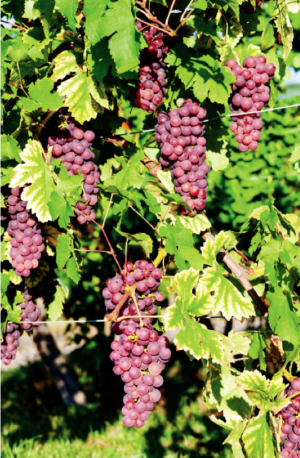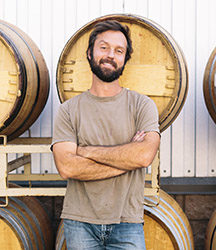 Why make a wine you can’t even pronounce? If you’ve ever tasted a Gewürztraminer, you already know the answer. At its finest, this most distinctive white wine has an exotic, spicy flavor with hints of ginger and cinnamon. It is full-bodied, dry and slightly fruity.
Why make a wine you can’t even pronounce? If you’ve ever tasted a Gewürztraminer, you already know the answer. At its finest, this most distinctive white wine has an exotic, spicy flavor with hints of ginger and cinnamon. It is full-bodied, dry and slightly fruity.
Gewürztraminer grapes are as unique as the wine. The origin of the fruit, as well as the name — it means “spicy” in German and is pronounced guh-VERTZ-truh-meener — is the Alsace region of southwestern Germany. The berries are small and often a pretty pink color, depending on how ripe they are. The clusters grow tight to the main vine, making them difficult to pick by hand. Alsace winemakers are renowned for coaxing a spicy characteristic from this native varietal.
On this side of the Atlantic, the grape is mostly grown in California and New York, since it does best in regions with warm days and cool nights. Afternoon sun builds the fruity characteristics in the grape, while the chill of evening helps stabilize the flavor compounds.
From finding the uncommon grapes to fermenting the delicate wine, making Gewürz is no simple task. To guide home winemakers through the process, we turned to Linda Trotta of the Gundlach Bundschu Winery.
Located in the southern end of the Sonoma Valley in California, Gundlach Bundschu was established in 1858. Today, the winery bottles 18 different wines (including Merlot, Cabernet Sauvignon and Zinfandel) and grows 11 different varietals.
Trotta has been the company’s winemaker for the last decade. She holds an Enology degree from the University of California at Davis and worked at the St. Francis and Sebastiani wineries before taking charge of wine production at Gundlach Bundschu.
Why did we call Trotta? Because Gundlach makes a truly superior Gewürztraminer. Their dry, spicy wine won gold medals last year at the California State Fair and the San Diego National Wine Competition. The wine also has been praised in the pages of the Seattle Times, the Dallas Morning News, the San Francisco Chronicle and American Way (the in-flight magazine for American Airlines), among other publications.
Trotta says there are two main schools of thought on Gewürz-traminer production in the United States. In Gundlach Bundschu’s region, winemakers attempt to capture the spicy component of the grape. Farther north, in the Anderson Valley of California, Trotta says the wines are more floral. “Both are excellent examples of the style,” she says, “though the spicy flavor is my favorite part of Gewürztraminer. Ultimately, the final characteristics of the wine will depend on the microclimate where the grapes are grown.”
Pick Your Grape
Before getting started, home winemakers should brace themselves for a particular challenge: procuring the fresh fruit. According to Trotta, Gewürztraminer production is extremely limited in the United States. “It’s totally market driven,” she explains. “This simply isn’t a very lucrative wine to make.”
She cautions that it will be tough to find someone who grows Gewürztraminer. If you do, she doubts they will have any extra grapes to sell. But it’s worth a shot.
To get started, scour wine books, check out a local farmer’s market, surf the Internet, or prowl your local wine store and compile a list of wineries that produce Gewürztraminer. Then try calling and beg for some grapes. Nicely. (We did a little legwork for you. See “Finding the Grape” on page 25).
Proper handling of Gewürz-traminer grapes is very important. Pick them in the morning when the grapes are cool, and keep them cool throughout the entire process, from picking to bottling. Warmth does two things: It makes the grapes lose their fruity characteristic and it enhances the bitter qualities.
Get Crushed
Since stems are a source of horrible bitterness, you should now de-stem your grapes. Do your best to keep the grapes intact.
Next move on to the crush. Whether you go with the old-fashioned foot stomping or a high-tech bladder press, avoid overpressing your grapes. The best way to do this is to taste the run-off often. As soon as you taste bitterness, stop pressing. If you’d like to extract the remaining bitter juice, use a different container and ferment this separately from the primary batch.
Trotta stresses that cool temperatures are very important at this stage. These keep the fruit characteristics of Gewürztraminer intact while preventing any indigenous yeast from starting to ferment. To achieve the right temperatures, Trotta sends the juice to a cold tank and chills it to 40° F.
During this phase, any solids that make it through the press separate from the clear juice. The juice is then racked off these dropped-out solids and sent to the fermenter.
Meanwhile, the solids are filtered. Any juice that results from this process is fermented separately. This product usually is bitter. In this case, Trotta will not use it in the finished wine. If the resulting wine turns out OK, she blends it into the larger batch.
Pitching the Yeast
Trotta uses Prisse de Mousse yeast to ferment her Gewürz-traminer, but suggests this probably isn’t the best strain for home winemakers. “This is a very vigorous yeast,” she says. “It’s a hard one to stop. It will go until the wine is very dry and leave hardly a trace of residual sugar.”
For home winemakers, she recommends Epernay, a user-friendly yeast that enhances the fruity qualities of wines. Another choice might be Champagne yeast. Regardless, the right yeast should leave behind about 0.5% residual sugar.
Fermentation Temps
Because this is a white wine, there is no need to punch skins down during fermentation (they were removed after the press). Concentrate instead on keeping the fermenting juice cool — Trotta shoots for levels between 50° and 55° F. On average, fermentation will last 10 days at these temperatures. If it goes faster, that’s a good way to determine that fermentation temperatures may have been too high. If it’s longer, your yeast is sluggish. Be sure the temperature hasn’t dropped below 50° F.
Trotta says traditionalists often ferment Gewürztraminer in “neutral” oak casks. These casks have seen several years of continual use; previous wines have already absorbed the wood’s flavor and none is left for the fermenting Gewürz. Still, the neutral barrel will build up the body, add depth to the finished wine and take some of the bite out of the fruit.
Managing the Sugar
Keep a careful eye on your residual sugars throughout fermentation. If you do not have yeast that flocculates on its own, you will want to arrest the process between 0° and –1° Brix. Trotta employs the following steps to do this: First, she rapidly chills the solution’s temperature to 32° F. This knocks out the yeast. Second, she centrifuges to extract the yeast from the solution. Finally, she adds sulfur dioxide at 50 ppm to kill any remaining yeast.
Recognizing that these tactics are the distant dream of most home winemakers, finding the right kind of yeast is your best way to manage residual sugar. Should this prove impossible for some reason, steps one and three can probably be useful in the home. An old refrigerator can be used to chill carboys. You might also try placing the fermenter in a metal tub and covering it with ice. You’ll need lots of ice for this to be effective.
Besides killing yeast, sulfur dioxide also prevents oxidation and bacterial growth. For this reason, learning to use SO2 is one of the most important skills for a home winemaker. A good rule of thumb for most wines is to add about one teaspoon of SO2 (or 50 mg/L) to stop fermentation, then one teaspoon every time you rack. This poses one problem, however: You could easily over-add the SO2, which might overwhelm the delicate, fruity qualities of your Gewürztraminer. For this reason, it’s best to add one teaspoon to stop fermentation, but only 1/4 teaspoon at each racking if you discover a hint of oxidation. If the wine is fine, don’t add any at all.
Neutral Aging
Because Gewürztraminer emphasizes fruit, Trotta says you should not age the wine on oak. “This will make it taste like a Chardonnay,” she says. Stick with glass carboys, and keep them filled to the top. This helps prevent oxidation, which can occur if your wine comes in contact with air after fermentation. Instead of topping up with water, which might thin the wine, use a mellow white wine like Chablis or Sauvignon Blanc.
In preparation for bottling, Trotta adds bentonite fining. “This is a volcanic clay that reduces hazing in the finished wine,” she says. Bentonite is the closest thing to an all-purpose fining agent. Try adding about 2 teaspoons to 2 cups of boiling water. Let the solution cool, then mix into 5 gallons of wine.
Next, she cold-stabilizes the wine by chilling it to 32° F. During this step, Trotta continually tests the wine for tartrate crystals — that glass-like sediment that you sometimes find in a bottle of wine. “Our customers don’t like that,” laughs Trotta. “Even though the crystals are completely harmless, people act like we’re trying to kill them if they see the crystals in our wine. So we hold temperatures down until there is absolutely no sign of crystals.”
To test for crystals, Trotta takes a sample from the main batch and holds it at 32° F. If crystals form, which usually happens within five days, the wine needs to cold-stabilize longer. She repeats the testing and observation until no crystals form, all the while holding the main batch at freezing.
From Start to Finish
Gundlach Bunschu picks their Gewürztraminer grapes in September and bottles in mid-December. Typically, the wine is drinkable by early spring. Trotta says home winemakers will need about six months before their wine is ready to drink.
A good, mature Gewürztraminer pairs well with spicy cuisine. Among Trotta’s favorite recommendations are Thai, Cajun and Mexican food.
In closing, Trotta shares these words of wisdom: “I imagine it is tough to make Gewürztraminer at home unless you have a really great cooling system. When you’re dealing with these grapes, cool temperatures are really key.” Good luck and good Gewürztraminer!
Finding the Grape
It’s not easy to locate fresh Gewürztraminer grapes. They aren’t grown in many commercial vineyards, and when they are, the competition is fierce. To begin your search, surf the Net or visit your local wine shop to compile a list of wineries that make Gewürz. Then start calling around. Here are a few options:
- If you live near the Finger Lakes region of New York, you’re in luck. Fall Bright Winemaker’s Shoppe in Dundee (tel: 607-292-3995; e: [email protected]) sells fresh grapes for $1.20 a pound. Grapes must be reserved well in advance of the fall harvest. You can also buy fresh Gewürz juice from Fulkerson’s Winery in Dundee for $15 a gallon. Call (607) 243-7883.
- Brehm Vineyards sells (and ships) five-gallon pails of frozen Gewürz juice that requires no sugar addition. Call (510) 527-3675 or check out the company’s Web site: www.brehmvineyards.com/grapes/gewurz.html.
- Buy a wine kit. Many companies make excellent Gewürztraminer kits. For a complete list, check out the comprehensive Wine Kit Buyer’s Guide that’s bound into the middle of this issue.







